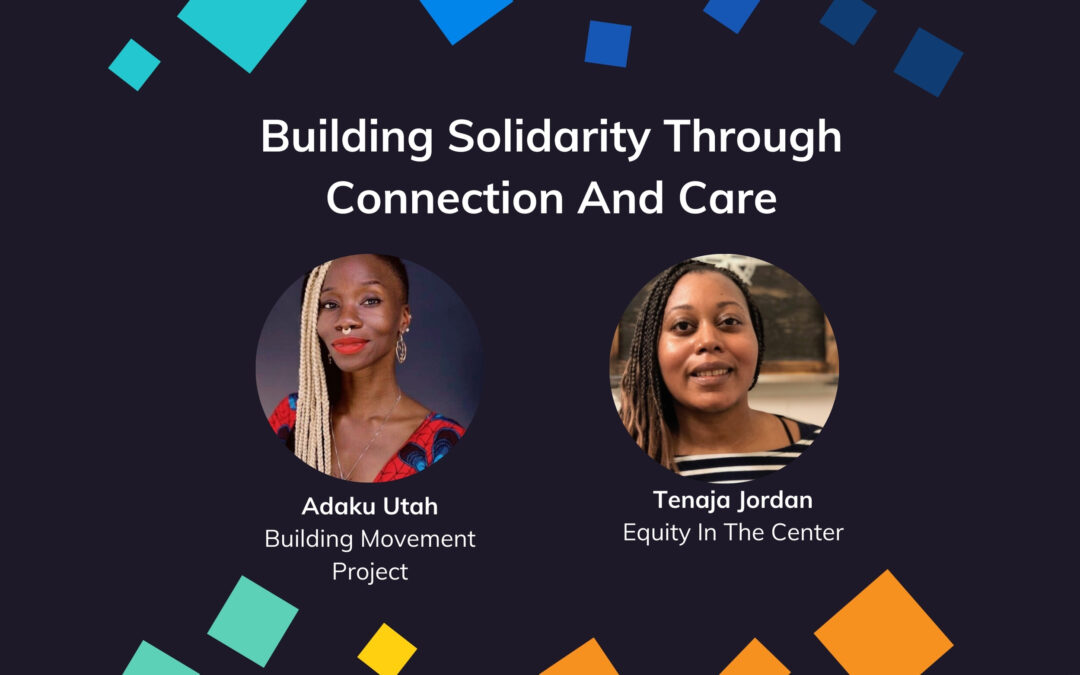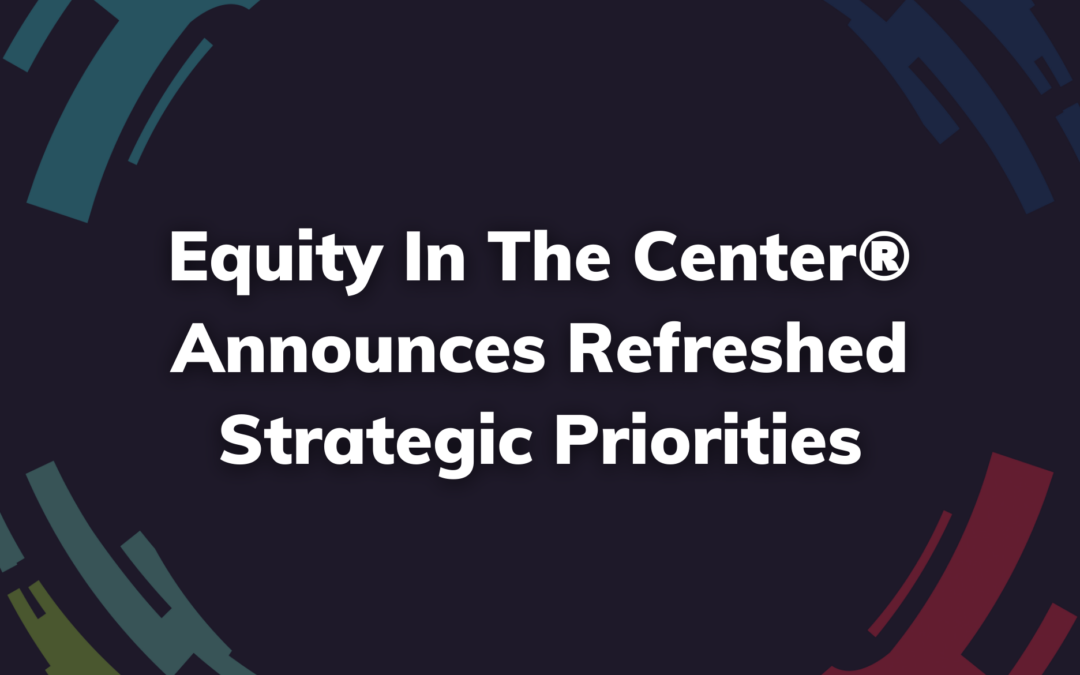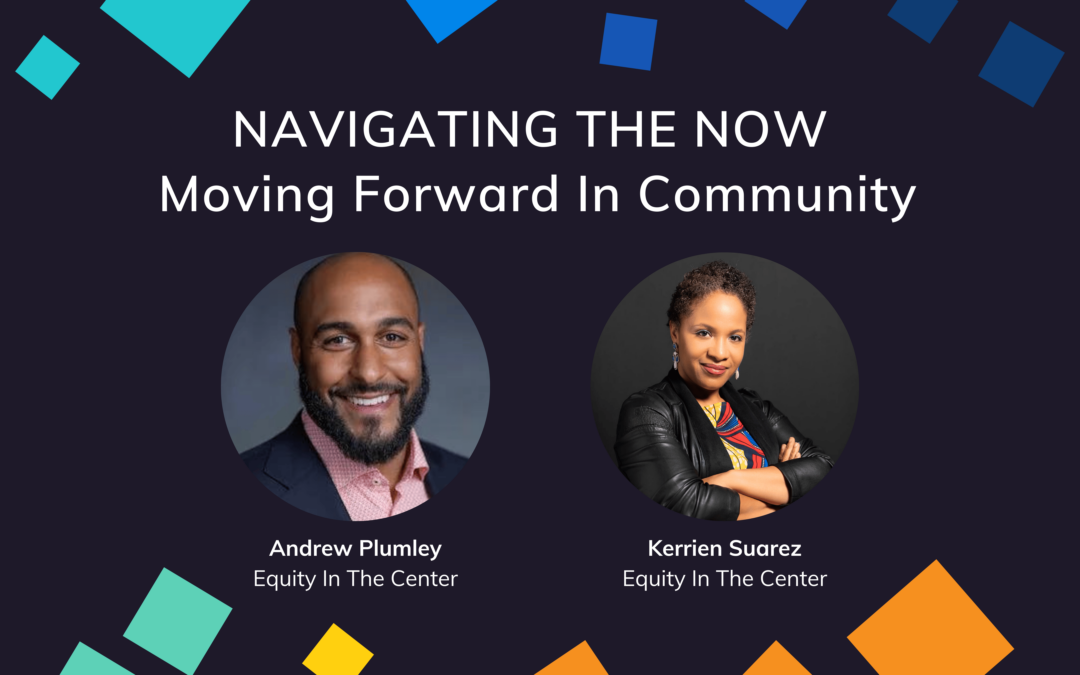Written By Kad Smith, Project Director, CompassPoint

This is the third blog in our series around our journey to center racial justice, equity, and a vision for leadership in service of liberation at CompassPoint. If you missed the first two installments, catch up here and here. In this second part of our blog series, we’re talking about the importance of centering relationships.
I remember joining CompassPoint at a time when our team was starting to intentionally center racial justice and equity. Since then, so much has transpired at our organization, and the way we embrace our work has drastically changed. As I sit down to try and convey some of the key elements of our collective transition, the process of looking back on my own journey, the many journeys of my colleagues (current and former), and the transformation of our organization feels daunting, while also immensely inspirational.
It feels important to say, my reflections on these past few years are my own, though in this piece I intend to reflect on things that have impacted the lives of many folks who’ve worked at, and with, CompassPoint.
In our most recent blog in this series, we talked about how we started to frame our collective challenge at CompassPoint: a vision to name and dismantle white dominant culture in ourselves and our organization. But changing our culture in service of equity isn’t an abstract idea—it’s rooted in relationships and community.
If the goal is to work towards racial justice and equity with our partners, how can we not have a workplace where folks talk about their experiences with systemic oppression? How can we not acknowledge the moments in our lives where we’ve been privileged by virtue of some of the identities we hold? At CompassPoint, we’ve maintained that racial justice and equity work has to happen from the inside out.
In this blog, we’ll share some of the structures and frameworks that helped us to begin shifting our culture at CompassPoint. Most importantly, we’ll acknowledge how, at its core, our collective transformation has required us to change our relationships to our own stories, to each other, and to the way in which we approach our work. We’re sharing our story not because we think it’s perfect or complete, but because we think there’s some wisdom and possible inspiration for your own efforts. One thing is certain: there’s no prescribed plan for doing this kind of work, so think of this as an offering rather than a “how-to.”
Building Community
White Dominant Culture and Patriarchy have indoctrinated us into normalizing many characteristics that are counterproductive to the ways in which we deserve to exist within our work. White Dominant Culture norms encourage a false sense of urgency and to measure our value by how much and how fast we “produce.” It encourages us to believe that the workplace is one where we can only bring pieces of ourselves. Embodying racial justice and equity means rejecting the notion that taking the time to make room for personal stories, voices, and experiences isn’t valuable.
Transitioning from a community built on extractive relationships to one of mutual care and support means making room for courageous conversations and healing. It means sharing our politics in the deepest sense by inviting us to share what drives us to make change in the world. It means fundamentally thinking about the way we relate to one another, finding safety in our similarities and solidarity in our differences.
In my time at CompassPoint, the most rewarding aspect of working here has been uprooting the way in which I once thought of “working relationships.” I think about the moments they solidified into something special, where memories became engraved and let me know that trust was truly established—whether it’s through tears of joy I shed at a beloved colleague’s wedding or the long embraces extended by so many of my folks as I prepared to lay my grandmother to rest.
Growing closer isn’t just in service to the work of CompassPoint, it’s in service to our humanity. When we go to work and know that we’re cared for, valued, and believed in, it allows us to feel a sense of belonging and pride, and a level of togetherness that can’t be appraised. But opening ourselves up to sharing our sacred truths is no small request. When we open ourselves up in the pursuit of wholeness, we will also have moments of being hurt, harmed, or disappointed which can leave us feeling even more broken.
I don’t intend to paint an image of CompassPoint as some organization that “has it figured out”. In my four years here there has been pain, there has been harm, and there have been deep ruptures. As folks committed not only to the future of this organization but also the futures of the folks who comprise it, we are accountable for acknowledging those ruptures where they have occurred, for trying to provide healing where there has been harm, and ultimately trusting that when we give folks space to work through pain, there’s deeper trust and connection to be established on the other side of it. The same is true for the leaders, organizations, and movements we work with.
Frameworks Toward Building Community
There have been several key frameworks that have helped us shape the kind of community we want to be in service of racial justice and equity. Listed here are a few that I think have taken root, gone “viral”, and showed up not only in our internal work but our external work, too.
Building a Shared Language: White Supremacy Culture and Understanding Different Types of Racism
So much of what keeps us divided and from exploring the beautiful potential of relationships is fortified by the ways racism plays out in our lives. All of our institutions, organizations, networks, and groups in some way are impacted by racism. But it begs the question—when we talk about racism, are we even talking about the same thing? Building a shared vocabulary is not only essential in building common understanding, but it’s catalytic in dismantling the social pillars that uphold racism in our everyday lives. If racism is the colossal wedge that keeps us from solving so many of the worlds perils, it’s imperative that we begin to truly sit with just how pervasive it is—within ourselves, within our relationships, and within the spaces we navigate.
The framework of “White Supremacy Culture” has become core to our understanding of how pathological behaviors and detrimental habits often become standardized ways of being in an organizational setting. This piece, authored by Tema Okun and Kenneth Jones, lists out habits such as Perfectionism, Fear of Open Conflict, and The Right to Comfort as norms and standards that ultimately isolate us and get in the way of community.
If White Supremacy Culture exists to rob so many of their humanity, then understanding that we can be in choice in the ways we adamantly reject it has felt like a huge unlock and guiding conversation for the type of changes we want to steward here at CompassPoint.
Another key framework for us at CompassPoint has been understanding the different manifestations of racism. Often, we focus on interpersonal racism (for example, someone saying something to someone else that’s rooted in bigotry or hate). But there are levels to this racist sh*t. Through our work with co-LAB (Maura Bairley, Monica Dennis, Viveka Chen) we introduced more of a collective, multi-layered understanding around the ways in which racism materializes individually, interpersonally, institutionally, and culturally.
We identified how these levels of racism have been foundational to our experiences, inform our views of the world, and often are what constitute the very systems we are actively working to dismantle. For some, this process was an affirmation of truths they’d already known their entire lives. For others, this framing felt like an inroad towards gaining a newer depth of understanding. The beauty of the framework is that it provides some guided direction in showing what our collective learning arc might look like as an organization. Explicitly naming that the forces which help racism thrive are beyond just you and me and that they are instead rooted in historical systematic oppression can be overwhelming and exhausting. And yet, it’s imperative for us to be reminded that the eradication of racism won’t happen overnight because it’s taken hundreds of years to become entrenched and normalized in our society.
Structures Toward Building Community
The frameworks we shared above have helped expand our thinking, made possible new experiences around how we connect to each other, and given us permission to show up in our full truths. Yet, within an organization working to build community, frameworks can only go as far as the structures that help to foster deep experimentation and integration. We’ve also spent the last few years exploring structures to truly help us live into our vision and values.
Working With Outside Consultants
We worked with consulting group co-LAB in a number of ways. Most importantly, they helped us interrogate some of the ways harm was permeating through our system and to explore the impact it was having.
In any organization or community, you’ll have conflict. The absence of conflict is not what an organization committed to social transformation should be seeking. Instead, it’s about how we address the sources of conflict, how we actively work toward resolution, and how we heal from ruptures that prevent us from building trust. Our work with co-LAB was immensely helpful in practicing what healing in our community could look like.
While consultants can provide crucial and profoundly important perspective, the main ingredients for an organizational metamorphosis are time, trust, and deep care. The limitations of working with consultants are that if time is scarce—which it often is in the context of larger systems and structures that don’t value, and can even be threatened by, this work—we can’t deepen our trust. In the absence of deep trust, their reflections, their insights, and our reactions aren’t able to take root. These partnerships need to be resourced adequately to reflect the complexity of the change we’re seeking.
Affinity Spaces
We’ve already written about our experiences with racial caucusing here and invite you to take a closer look. The beauty of Affinity Spaces at CompassPoint is that they’ve taken a few different shapes to meet a wide range of needs. At their core, Affinity Spaces are another way in which we’ve been intentional about identifying opportunities for folks to grow closer, to share experiences that they need perspective on, to be co-learners together, and have some resourced time and space to just “be”.
Affinity Spaces are not without their limitations either. When we break out into subclusters and there is progress made within one group, figuring out how to reconvene and integrate learnings that we’ve had separately can be perplexing. Ultimately, there is some sanctuary extended in Affinity Spaces when utilized correctly, but at CompassPoint we’ve also been curious about how to more intentionally find ways to bring our Affinity Groups back together with the level of honesty, realness, and compassion that is needed to bring our experiences full circle.
Modified Circle Process
Over the past few years, we’ve also used a modified version of Circle process (a practice that we learned about through a training with Rita Renjitham Alfred) at key points.
As this resource from Living Justice Press points out, it’s important to acknowledge that “Non-Natives who now use talking Circles have, directly or indirectly, learned Circle values and practices from Indigenous people.” We should also point out that although we’ve used adapted versions of Circle Process, we don’t have a restorative justice practice at CompassPoint—that approach represents a specific school of practice, discipline and tools. We should also lift up that we’ve used Circle Process at a few key points in our story, but that it should really be practiced with regular intention, rigor, and discipline.
Circle Process has been a useful way of challenging White Supremacy Culture in so many ways. For instance, the notion that we should avoid conflict or that certain folks have an expectation towards some right to comfort that’s contingent on the silencing of the truths of others? Well, it all goes out the door when the space is given for folks to truly share how they’re feeling. When we provide space for folks to share their truths, we begin to see that binary thinking often forces us into false dichotomies and limits our ability to see how multiple truths can coexist at any given time.
Circle Process isn’t easy. It’s a structure that inherently takes time, requires folks to fully lean in to listening (both to what’s said and what’s not said), and asks everyone to be vulnerable.
Designing Alliance
Another relationship-building practice that has taken root at CompassPoint is “Designing Alliance”, a tool often used by coaches that came to us via LeaderSpring. Designing Alliance is a guided process that’s ideal for exploring one-on-one relationships or small team dynamics. It can be used to surface our highest hopes for one another, to make explicit our greatest fears about working together, and to directly determine how we want to be in conflict with one another. To me, the real value of introducing it to CompassPoint as a regular practice has been seeing how it gives permission for us to prioritize conversations that are supportive of building stronger relationships prior to jumping into new work. Instead of thinking about our relationships within the work as solely designed to move forward important tactical demands, the Designing Alliance framework encourages us to identify the ways we work together to achieve our highest purpose here at CompassPoint. It pushes us to be not only introspective, but deeply attuned to the needs, desires, and aspirations of those we work closest with.
Dismantling Racism and Confronting Inequity is Evergreen Work
Centering relationships may not seem revolutionary to many folks who come from movement spaces or have taken the time to organize in their communities (even though those spaces can and do also deal with toxic dynamics and the creeping in of habits of white supremacy). I get that and I feel that. Yet, transforming our traditions around relationships within a 40+ year old organization has felt like no small task.
The emotional labor that drives culture shift is a component that can’t be easily quantified. I would be remiss to not provide an account of how I’ve seen this labor fall unevenly on Women of Color in our organization and especially on the Black women of CompassPoint. In many ways, it’s been their leadership that has demonstrated how embracing new ways of being together and going at this work is not only possible but imperative if we truly intend to live into the values we have recognized as central. That work has not been without risk and burden and I want to extend my gratitude to my colleagues for truly enhancing my understanding of not only what’s achievable but what’s necessary in the pursuit of equity and justice.
I think in my time here, I’ve realized that there is no “step by step” or “right way” to go about forging the types of organizations that social and racial justice work requires. There’s no way to predict how people will feel impacted by embracing different ways of being, practicing alternative ways of showing up, and responding to a new type of leadership that feels diametrically opposed to so much of what we’ve been indoctrinated to think is “the right way.”
The power of relationships is that we can take care of each other and show up for each other, so we can keep coming back to the table, hurt after hurt, failure after failure, because there is no right way—just evergreen effort. And the only way to sustain that longevity in effort is through relationships.
All of the frameworks and structures in the world are only as valuable as the way in which they show up in the ways we treat each other. I am so grateful that CompassPoint has helped change my relationship to what I think an organization can provide in folks’ lives and I look forward to continuing to pay that discovery forward with my comrades here and across the organizations with which we hope to build long standing relationships across the sector.
About the Author
Kad Smith is a project director with CompassPoint. In his time at CompassPoint Kad has specialized in program design and the facilitation of CompassPoint’s cohort leadership programs. Outside of his work with CompassPoint’s cohort leadership programs, Kad enjoys facilitating workshops in CompassPoint’s public training program where he covers a broad range of content and topics. For Kad’s full bio, click here.
Read the other blogs in this series:
Resources:
- White Supremacy Culture by Kenneth Jones and Tema Okun
- About the Circle Process from Living Justice Press
- Rita Renjitham Alfred Co-Founder of the Restorative Justice Training Institute
- Racism 101: Understanding Race and Racism from Showing Up for Racial Justice
- Undoing Racism 101: from the People’s Institue for Survival and Beyond



